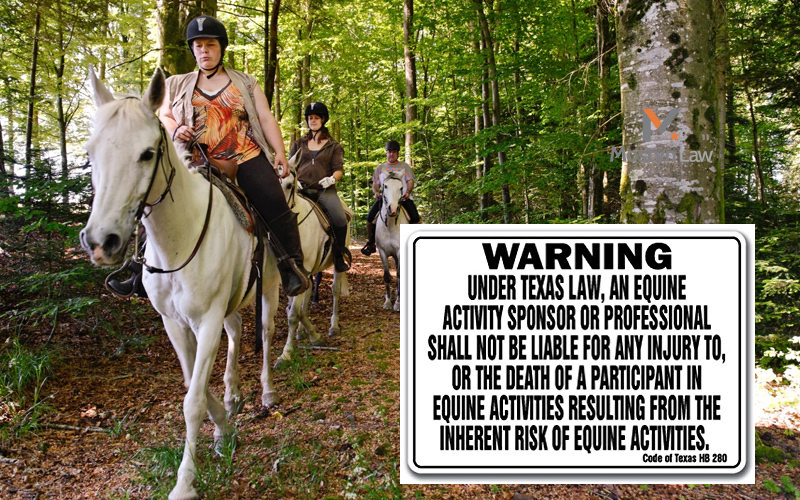As the saying goes, everything is bigger in the Lone Star state, including the broad all-encompassing law that protects landowners who own farm animals. Texas landowners can now put their mind at ease knowing the Legislature has passed laws to limit potential expose to lawsuits involving farm animals. Barn operators and other equine industry professionals in Texas are now protected from liability connected to injuries sustained during farm animal-related activities under a limited liability law that was amended and went into effect in 2011. The Texas Farm Animal Limitation of Liability Act (“the Act”), immunizes barn operators, riding instructors, and trainers from liability connected to equine activities on grounds that such activities carry inherent risks. The law also extends protection to veterinarians, farriers, owners, and horse show sponsors who are involved in farm animal activity.
The Act was originally passed in 1995 and applied only to equine animals. In 2011, the Texas Legislature expanded the statute to apply to not only equine animals, but to all farm animals. Forty-six states, all but California, Maryland, Nevada, and New York, have enacted similar equine statutes, although each state’s statute greatly differs in details. The purpose of the Act is to encourage participation in farm animal activities, to ensure the public is aware of inherent risks of farm animal activities, and to provide limited liability to farm animal facility operators. However, if a landowner or participate in equine activities does not comply with the Act, they could have exposure to potential liability in the event of a claim.
The Act provides that certain defendants are not liable for property damage, or personal injury or death so long as each of the Act’s requirements are met. The limited liability of the Act applies to the following defendants:
(1) Farm animal professionals (persons engaged for compensation in instructing a participant or renting to a participant a farm animal for the purpose of riding, driving or being a passenger; renting equipment or tack to participants; providing medical care to a farm animal; or providing farrier services);
(2) Farm animal activity sponsors (persons who sponsor, organize or provide facilities for farm animal activities or operators, instructors, or promoters for facilities where farm animal activities are held);
(3) Livestock producers (person who owns, breeds, raises, or feeds livestock animals);
(4) Livestock show sponsors (groups that sanction livestock shows); and
(5) Livestock show participants (person who registers for and is allowed to compete in a livestock show by showing an animal on a competitive basis, or a person who assists the show participant).
The Act is a comprehensive limitation of liability for farm animal activity of all kinds, which includes shows, fairs, performances, rodeos, or events involving farm animals; training or teaching activities involving farm animals; boarding farm animals; daily care of farm animals; riding, inspecting, evaluating, hauling, loading, or unloading a farm animal belonging to another; informal farm animal activities including rides or hunts; shoeing horses; providing medical treatment to animals; and rodeos and ropings. Persons are engaged in farm animal activities if they are riding, handling, training, driving, loading or unloading, assisting in medical treatment of, being a passenger on, or assisting a participant or sponsor with a farm animal. To be protected under the Act, all “participants” must be engaged in “a farm animal activity without regard to whether the person is an amateur or professional or whether the person pays for the activity or participates in the activity for free” and a person who registers for and is allowed to compete in a livestock show or a person assisting the competitor. The Act does not apply to spectators at farm animal activities unless the spectator is in an unauthorized location in the immediate proximity of the farm animal activity.
The Act’s limited liability protections apply to any “property damage, injury, or death resulting from the dangers or conditions that are an inherent risk of a farm animal activity or the showing of an animal on a competitive basis at a livestock show.” Further, the Act offers a laundry list of the types of injuries that would be covered: (1) propensity of a farm animal to behaving in a way that may result in personal injury or death to persons around it; (2) unpredictability of farm animal’s reaction to sound, sudden movement, or unfamiliar object, person, or other animal; (3) with respect to equine animals, certain land conditions and hazards including surface and subsurface conditions; (4) a collision with another animal or object; and (5) the potential of a participant to act in a negligent manner that may contribute to the injury of the participant or another. While the Act provides immunity from injury or death resulting from inherent risks, there are six exceptions to immunity under limited circumstances when the injuries or death are caused by one or more of the following acts and/or omissions: (1) knowingly supplying faulty tack or equipment; (2) failing to determine a participant’s ability; (3) injury was caused by a known hidden defect; (4) failing to warn of latent land conditions; (5) wilfully or wantonly disregarding safety; and (5) intentionally causing injury or death. The structure of the Act shows that but for these exceptions, these risks would also be considered inherent in equine activity. The statute also mandates all farm animal profession or farm animal activity sponsor to post warning signs in a clearly visual location on or near a stable, corral, or arena where farm animal activities are conducted. Failure to do so may waive immunity under the Act.
In sum, the limitations on liability and the exceptions to the limitations are both factually intensive inquiries under the Act. In fact, the few Texas appellate courts to interpret the Act have reversed summary judgments and remanded for factual determinations. Thus, the early indications are that juries will generally be required to determine whether the liability limitations or the exceptions to the limitations are applicable in any given case.

